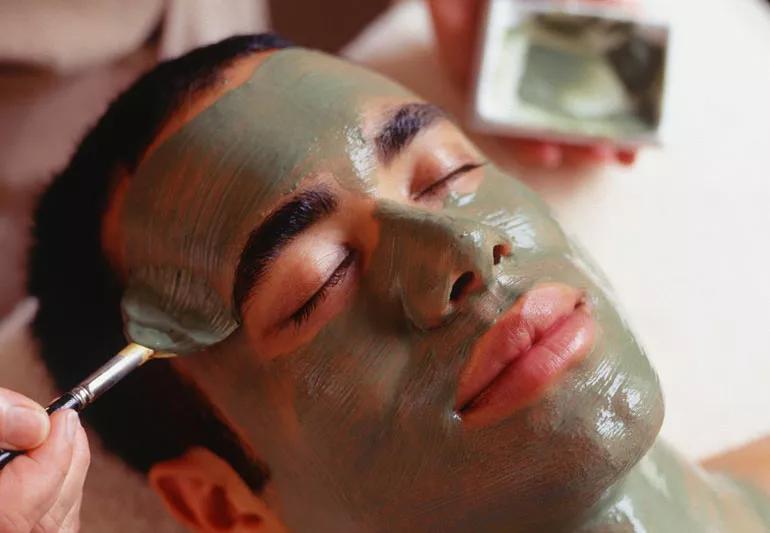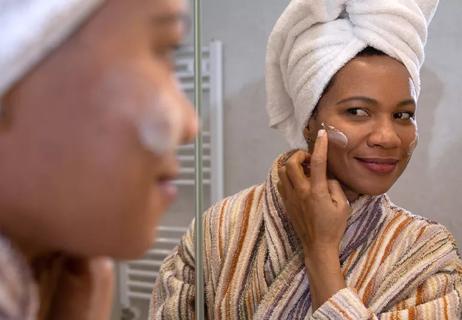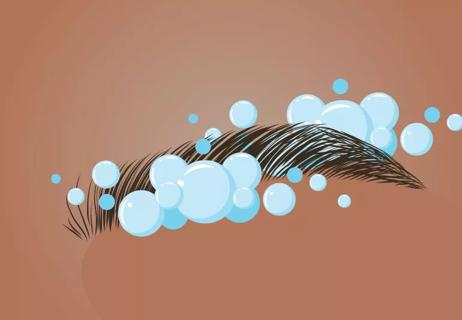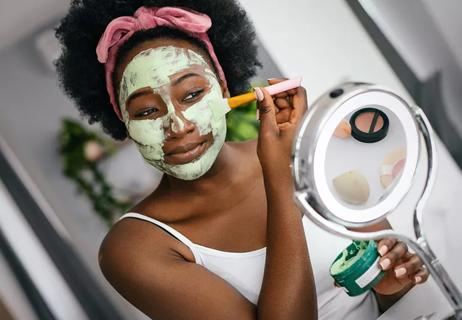Lie back and relax as a skin specialist cleanses, exfoliates and hydrates your skin

If you’ve never gotten a facial, you might not totally understand the appeal. Why would you need someone else to wash your face for you? But facials are so much more than that — and in addition to feeling great, they have huge benefits for your skin.
Advertisement
Cleveland Clinic is a non-profit academic medical center. Advertising on our site helps support our mission. We do not endorse non-Cleveland Clinic products or services. Policy
“There are so many benefits to receiving skin treatments and having a good skin care regimen,” says aesthetician Amanda Kanaan. “Aestheticians are extensively trained in various skin types and conditions, and our goal is always to figure out how to make your skin look its best.”
She explains the basics of facials, plus some of the add-on treatments that are sometimes offered along with them.
A facial is a noninvasive skin treatment that includes cleansing, moisturizing, exfoliating and other elements that are customized to your specific skin type and needs. Facials are performed by licensed skin care professionals like aestheticians, and they’re intended to:
“A facial is like a big drink of water for your skin,” Kanaan says. “After a treatment, your skin will look healthy, hydrated and radiant.”
Even people who have clear skin can benefit from facials — especially because clear skin doesn’t always equate to healthy skin. Facials can help hydrate, plump and protect your skin for the long haul.
“Doing these treatments allows your skin to be continuously exfoliated, which helps bring forth new skin,” Kanaan explains. This helps to:
Advertisement
“Skin care treatments also help increase blood circulation,” Kanaan says. “Good blood circulation in the skin helps to kill bacteria and promote cell regrowth, which is very important for collagen production.”
Collagen is a type of protein that gives your skin structure, strength and elasticity. As you age, though, your skin naturally begins to produce less collagen, which can lead to wrinkles, sagging and other signs of aging.
If you’ve ever looked at a menu of spa services and felt overwhelmed by all the different types of treatments they offer, you already know that there are different kinds of facials and all kinds of add-ons to choose from. How are you supposed to know what’s what?!
Your standard facial is anything but basic! They typically include:
They may also involve:
“After a facial, your skin may have a bit of a pink flush to it from facial massage and stimulating ingredients,” Kanaan says, “but that’s a good thing. It will subside quickly throughout the day.
“This is a three-in-one service that exfoliates, extracts and infuses serums into your skin,” Kanaan explains. “The HydraFacial® uses a chemical peel to exfoliate the skin and is geared toward overall skin health and rejuvenation.”
Your aesthetician performs a HydraFacial using a special, patented, wand-like tool that works kind of like a miniature vacuum. It helps open your pores so you can get a deeper, more effective cleanse. This noninvasive skin resurfacing procedure includes:
You can also add customized “boosters” — additional aesthetician-recommended serums that can improve the overall results of your facial.
A DiamondGlow® facial, also known as Dermalinfusion®, is also a three-in-one treatment for exfoliating, extracting and hydrating. It’s performed with a gentle dermabrasion device that can help smooth your skin, add volume and give you a more youthful look.
Advertisement
“It uses a mechanical exfoliation with a diamond tip and tackles specific skin concerns like acne, wrinkles and dry skin,” Kanaan says.
Who doesn’t love a bonus?! Depending on what kind of facial you’re getting and where, you may be able to choose from custom add-ons that can further improve your skin.
But to keep cost down, don’t feel pressured to pile on the add-ons. “They’re great if and when your skin needs an extra boost, but they’re not necessary each time,” Kanaan notes.
We’re talking about the relaxing kind of face masks, not the COVID ones! Most standard facials include some type of personalized mask, but you may also have the option to add another mask targeted at anti-aging, collagen production, moisture retention or some other specific skin goal.
This painless micro-exfoliation process, also known as dermaplaning, removes the top layer of your epidermis.
“It sloughs off dirt, debris, dead skin and superficial facial hair,” Kanaan explains. “In turn, this helps ensure that any product or procedure used right afterward can penetrate and absorb deep into the skin, which can accelerate your results.”
You should never pop a zit on your own — but trained providers have the skill and background to safely perform extractions on blackheads (open pores clogged with oil and dead skin) and whiteheads (closed bumps full of oil and dead skin).
Advertisement
Extractions are sometimes included in facials and sometimes presented as add-ons. You may also be able to add on extractions of back acne.
Chemical peels use a chemical solution to remove layers of skin and encourage cell renewal.
“There are different types of peels, all designed to do different things for your skin,” Kanaan says. “Which kind you get will depend on your specific needs and your provider’s recommendations.”
Some of the facial acids most often used in chemical peels are:
Like mood lighting for your face, LED light therapy treats various skin concerns like acne and fine lines. Different colors of light penetrate your skin at different depths and have different uses:
Have you ever heard of people breaking out right after a facial? It’s called “purging,” and there’s a good explanation for it: It’s your skin’s way of getting rid of any dirt, debris or bacteria that’s lingering beneath it. Getting a facial speeds up that process.
Advertisement
“It all comes out from beneath your skin after treatment, due to the rapid cell turnover,” Kanaan states. “It won’t last long and should subside a week or two after treatment.”
Purging is especially common after your first facial or when you start using any new products, so if you’re a newbie, it’s actually not a good idea to get a facial right before you attend any sort of big, photo-worthy event.
“The way to avoid constant purging is by keeping up with facials and great skin care at home,” Kanaan advises. “The more you treat the skin, the less will get caught in your pores and cause inflammation.”
The frequency of your facials depends on what type of skin issues you’re dealing with. Kanaan says every four to six weeks is ideal because it aligns with your skin’s natural cycle — about 30 days.
“It’s best to stay on a consistent routine, especially if there’s a specific skin concern that we’re addressing,” she says. “That will ensure that you get the best result.”
It’s also important to take good care of your skin in between facials so that you can maintain your results and continue to improve your skin health. After your facial, your aesthetician will provide you with skin care recommendations to help you better understand your skin’s needs and how to care for it.
Once your skin issues are better managed and your skin is glowy and thriving, you and your aesthetician can reevaluate the frequency with which you book your facials.
“At the beginning of your skin journey, stay on a regular regimen,” Kanaan recommends, “but once you’ve achieved results, you may be able to move to more maintenance-focused schedule and stretch out treatments further apart.”
In a word: Yes! “There’s having great skin and then there’s having great skin health,” Kanaan clarifies. “Getting regular facials can help you achieve both.”
But as with any skin and beauty treatment, it’s important to separate fact from fiction.
Facials are typically not covered by insurance, and depending on where you go, the expense can rack up quickly — especially because it’s common for spas to market their services with lofty claims about what they can do for you. In general, if it seems too good to be true, proceed with caution.
“Pick providers that are there to help you, guide you and work with you, not just someone who is focused on selling,” Kanaan advises.
If it’s an option where you live, look into booking your facial appointment at an esthetic clinic that is associated with a hospital or major health system.
Learn more about our editorial process.
Advertisement

Pantothenol is a powerful moisturizer and can help repair damaged skin and hair

This alternative to retinol may be easier on sensitive skin

Day creams should protect your skin, night creams should soothe and repair it

Pure cocoa butter can help keep your skin supple, with a subtly delicious scent

Focus on the philosophy — replenishing and respecting your skin — not necessarily the steps

The powerhouse oil fights fine lines and wrinkles, soothes sunburn and a whole lot more

From icing to taping, experts chime in on what’s worth trying and what’s better off skipping

Moisturizing, wound-healing, anti-aging: This botanic extract can do a whole lot for your skin

Type 2 diabetes isn’t inevitable with these dietary changes

Applying a hot or cold compress can help with pain